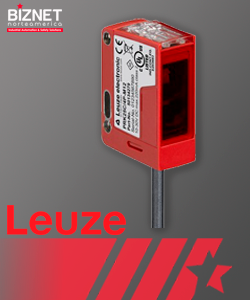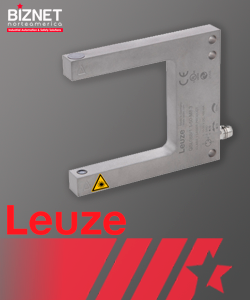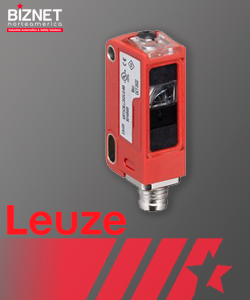TURNING TECHNOLOGY
INTO OPERATIONAL EFFICIENCY

CATEGORY:

Optical sensors use light in various forms to perform their detection tasks. An extensive product line is available with reliable and efficient sensor solutions for all applications that can be solved optically. Object detection for different surfaces, object sizes and colors requires various function principles, such as a throughbeam photoelectric sensor, a retro-reflective photoelectric sensor or a diffuse reflection sensor. All different operating principles are usually available in a given series (size). Universal series are also available with extended models and additional useful functions.
• Dimension (W x H x L): 15 mm x 42.7 mm x 30 mm
• Housing material: Plastic
• Plastic housing: ABS
• Lens cover material: Plastic
• Net weight: 55 g
• Housing color: Red
• Type of fastening: Through-hole mounting with M4 thread, Via optional mounting device
• Compatibility of materials: ECOLAB

Plastic fiber optics are suitable for universal applications with low space requirements for object detection. Glass fiber optics are used in demanding environmental conditions with high temperatures and are resistant to chemicals. For radiation through foils or applications with high light power, they offer further advantages through the especially low damping. The flexible fiber optics with various head shapes can be integrated in nearly any system design. The detection range is dependent on the fiber optics and amplifiers used.
• Design: Cylindrical
• Outer diameter: 4 mm
• Head material: Stainless steel
• Type: Glass fiber optics (GF)
• Fiber length: 200 mm
• Fiber sheathing material: Stainless steel
• Fastening of the probe: M4
• Smallest bending radius (static): R40
• Smallest bending radius (moving): R40
• Sleeve length at optical outlet: 15 mm
• Metric thread on fiber optic sleeve: Yes
• Laying: standard
• Damping at λ = 900nm: 700 dB/km

Fork sensors combine transmitter and receiver into a single device and therefore feature high operational reliability. They are characterized by simple mounting without the need for alignment as well as high sensitivity. The fork sensors are used for detecting small parts or for detecting labels and print marks, even on transparent films.
• Design: Fork
• Mouth width: 50 mm
• Mouth depth: 55 mm
• Dimension (W x H x L): 10 mm x 70 mm x 80 mm
• Housing material: Stainless steel
• Stainless steel housing: V4A
• Lens cover material: Glass
• Net weight: 112 g
• Housing color: Silver
• Type of fastening: Through-hole mounting
• Compatibility of materials: ECOLAB

Switching light curtains are perfect for monitoring large measurement fields. They react as soon as anything or anyone penetrates this field. Their fast configuration and simple handling save time and money compared to imaging processes. Thanks to different beam spacings and measurement field lengths, switching light curtains can be used to solve a range of application problems.
• Design: Cubic
• Dimension (W x H x L): 29 mm x 35.4 mm x 2,953 mm
• Housing material: Metal
• Metal housing: Aluminum
• Lens cover material: Plastic / PMMA
• Net weight: 2,850 g
• Housing color: Red
• Type of fastening: Groove mounting, Via optional mounting device

These devices scan their environment using a quickly-rotating laser measurement beam. This allows them to detect objects even at long distances. With an opening angle of 190° and a measurement distance of up to 65 m, the laser scanner can monitor an area of one hectare. Object detection occurs in parallel in up to 4 detection fields. Convenient configuration software RODsoft permits the parameterization of 8 detection field pairs and 4 detection fields. The status output takes place via a serial interface and an optional warning output. Should service be necessary, the device can be swapped out and put back into operation extremely quickly thanks to the ConfigPlug configuration memory.
• Dimension (W x H x L): 140 mm x 148 mm x 167 mm
• Housing material: Metal / Plastic
• Metal housing: Diecast aluminum
• Lens cover material: Plastic
• Net weight: 2,300 g

Contrast sensors detect and compare contrasts very precisely through the use of different light sources such as white light, laser-generated red light or RGB light. The detected contrasts marks are then reported to the process with minimal signal jitter. Through the automatic selection of the right transmitter colors, various color or gray value combinations can be reliably detected. Bar graph indicators offer additional ease in making adjustments during manual setup.
• Design: Cubic
• Dimension (W x H x L): 11.4 mm x 34.2 mm x 18.3 mm
• Housing material: Plastic
• Plastic housing: PC-ABS
• Lens cover material: Plastic / PMMA
• Net weight: 10 g
• Housing color: Red
• Type of fastening: Via optional mounting device
• Compatibility of materials: ECOLAB